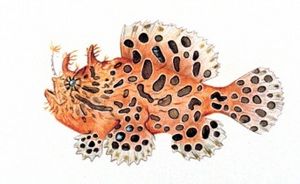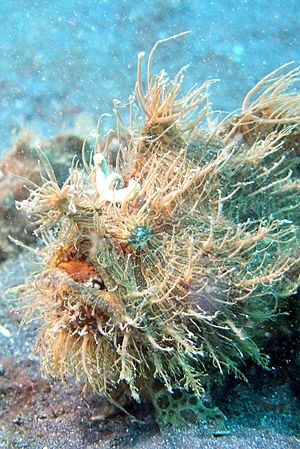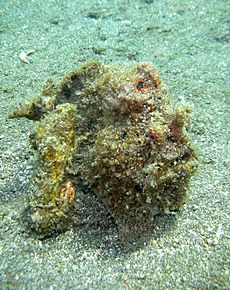Frogfish facts for kids
Quick facts for kids Frogfish |
|
|---|---|
 |
|
| Striated frogfish, Antennarius striatus | |
| Scientific classification |
|
| Kingdom: | Animalia |
| Phylum: | Chordata |
| Class: | Actinopterygii |
| Order: | Lophiiformes |
| Suborder: | Antennarioidei |
| Family: | Antennariidae T. N. Gill, 1863 |
| Sub-families & Genera | |
|
|
Frogfishes are amazing fish that belong to the anglerfish family called Antennariidae. They are found in warm, tropical, and subtropical oceans all over the world, but not usually in the Mediterranean Sea.
These fish are small, short, and chunky. They often have spiky bits or other growths on their bodies. This helps them blend in with their surroundings. Their amazing camouflage helps them hide from predators and also lets them trick other fish into becoming their prey. Many frogfish can even change their color! Some are covered with things like algae or tiny hydrozoa to look even more like their environment. Frogfish usually move very slowly, waiting for food to come close. Then, they strike incredibly fast, in less than a blink of an eye!
Contents
Where Do Frogfish Live?
Frogfish live in the warm parts of the Atlantic, Pacific, and Indian Ocean, as well as the Red Sea. They mostly live in areas where the water temperature is usually 20°C (68°F) or warmer. You can find them near the Azores, Madeira, and the Canary Islands. They also live along the Atlantic coast of the United States, southern Australia, northern New Zealand, and coastal Japan.
The most different kinds of frogfish live in the Indo-Pacific region, especially around Indonesia. For example, in a small area called Lembeh Strait in Indonesia, divers have found 9 different types of frogfish! These fish usually live on the ocean floor around coral or rock reefs, usually no deeper than 100 meters (330 feet).
There are a few special frogfish. The brackishwater frogfish can live in ocean water, brackish water (a mix of fresh and salt water), and even fresh water near river mouths. The sargassum fish lives in floating clumps of sargassum seaweed. This seaweed can drift far out into the ocean, sometimes carrying the sargassum fish as far north as Norway!
Amazing Features of Frogfish


Frogfish look very different from most other fish. They are usually between 2.5 and 38 centimeters (1 to 15 inches) long. Their bodies are plump, tall, and not streamlined like a typical fish. They don't have scales and are often covered with bumpy or spiky growths. Their mouths point upwards, and they have teeth inside.
They can be many bright colors like white, yellow, red, green, or black. Some even have spots to help them blend in with the coral. It can be hard to tell different frogfish species apart because their colors can vary a lot, even within the same type of fish!
Instead of a normal dorsal fin, the front fin on a frogfish is a special "fishing rod" called an illicium. At the end of this rod is a "lure" called an esca. The illicium often has stripes, and the esca looks different for each species. Because their colors can change, the esca and illicium are very helpful for telling different frogfish apart.
Some escas look like small fish, shrimp, or polychaete worms. Others are just a simple lump. One type of frogfish, Echinophryne, doesn't have an esca at all! Even though the esca looks like a specific animal, frogfish don't only eat what their lure mimics. If a frogfish loses its esca, it can grow a new one. Many species can pull their illicium and esca back into a special dip on their back to keep them safe when not in use.
Frogfish have small, round gill openings located behind their pectoral fins. Most frogfish use a gas bladder to help them float at different depths.
How Frogfish Use Camouflage
The unique look of the frogfish helps it hide from animals that might want to eat it. It also helps it trick other animals into becoming its food. This is called aggressive mimicry in animal behavior. Their strange shape, color, and skin textures make frogfish almost invisible. Some look like stones or coral, while others pretend to be sponges or sea squirts.
In 2005, a new type of striated frogfish was found that looks like a sea urchin. The sargassumfish is colored to perfectly match the sargassum seaweed it lives in. Some frogfish are even covered with algae or tiny hydrozoa. Their camouflage can be so good that sea slugs have been seen crawling right over them without realizing they are on a fish!
Being scaleless and unprotected, camouflage is super important for frogfish to stay safe from predators. Some species can also puff themselves up with water, like pufferfish, to scare away threats. When frogfish are out in the open, they can be attacked by fish like clownfish, damselfish, and wrasses.
Many frogfish can change their color. They can be light colors like yellow or yellow-brown, or darker colors like green, black, or dark red. They usually appear in lighter colors, but the change can take days or even weeks. Scientists don't fully know what makes them change color.
How Frogfish Move
Frogfish usually don't move much. They prefer to lie on the sea floor and wait for prey to come near. Once they spot food, they can slowly move towards it using their pectoral and pelvic fins to "walk" along the bottom. They rarely swim.
They have two main ways of "walking" on the sea floor. In the first way, they move their pectoral fins forward one at a time, pushing themselves along like an animal with two legs. The pelvic fins stay out of the way. In the second way, they move their pectoral fins forward and back at the same time, shifting their weight to their pelvic fins as they move. Both ways only let them cover short distances.
In open water, frogfish can swim by moving their tail fin. Younger frogfish often use a kind of jet propulsion. They do this by gulping water and then quickly forcing it out through their gill openings, which are behind their pectoral fins.
The sargassum frogfish has special fins that can grab onto strands of sargassum seaweed. This allows it to "climb" through the seaweed.
How Frogfish Hunt

Frogfish eat crustaceans, other fish, and sometimes even other frogfish! When a frogfish first sees potential prey, it watches it with its eyes. Then, if the prey gets within about seven body-lengths, the frogfish starts to move its illicium. The esca (lure) moves in a way that mimics the animal it looks like.
As the prey gets closer, the frogfish slowly gets ready to attack. Sometimes this means moving closer to the prey, or "stalking" it. Other times, it just means adjusting its mouth angle. The actual catch happens when the frogfish suddenly opens its jaws. This makes its mouth cavity up to 12 times bigger, sucking the prey and water into its mouth. This attack can happen in as little as 6 milliseconds! The water flows out through the gills, while the prey is swallowed. A special muscle closes the esophagus to stop the victim from escaping. Besides expanding their mouths, frogfish can also stretch their stomachs to swallow animals up to twice their own size!
Slow-motion videos have shown that frogfish suck in their prey in just six milliseconds. This is so fast that other animals can't even see it happen!
Frogfish Life Cycle and Reproduction
We don't know everything about how frogfish reproduce, as they usually live alone. Only a few observations have been made in aquariums and even fewer in the wild. Most frogfish release their eggs and sperm into the water. The female lays the eggs, and the male then fertilizes them.
About eight hours to several days before laying eggs, the female's belly swells up as she absorbs water for up to 180,000 eggs. The male starts to approach the female about two days before she lays her eggs. We don't know if something in the environment, like the moon, triggers the spawning, or if the male is attracted by a smell or signal from the female. In all observed mating pairs, one fish was much bigger than the other, sometimes 10 times larger. When the gender was known, the larger fish was always the female.
During the mating ritual, the male swims next to and slightly behind the female. He nudges her with his mouth and stays near her cloaca (a body opening). Just before laying eggs, the female starts to swim up from the ocean floor towards the surface. At the highest point of their swim, they release the eggs and sperm before swimming back down. Sometimes, the male even pulls the eggs out of the female with his mouth. After mating, the male and female quickly separate. If the smaller male stays too close, the female might eat him!
A few frogfish species lay their eggs on a solid surface, like a plant or a rock. These include the Lophiocharon, Phyllophryne, and Rhycherus types. Some species guard their eggs, and in almost all cases, the male does this job. Other species don't guard their eggs at all. Several species carry their eggs. For example, the three-spot frogfish attaches its eggs to the male, and frogfish in the genus Histiophryne carry their eggs in their pectoral fins.
The eggs are very small, about 0.5 to 1 millimeter (0.02 to 0.04 inches) wide. They stick together in a jelly-like mass or a long ribbon. In sargassumfish, these egg masses can be up to a meter (3.3 feet) long! These egg masses can hold up to 180,000 eggs. For most species, the eggs float on the surface.
After two to five days, the tiny fish hatch. The newly hatched fish are only about 0.8 to 1.6 millimeters (0.03 to 0.06 inches) long. For the first few days, they get their food from a yolk sac while their bodies continue to develop. The young fish have long fin filaments and can look like tiny, tentacled jellyfish. They float around as plankton for one to two months. After this stage, when they are about 15 to 28 millimeters (0.6 to 1.1 inches) long, they look like adult frogfish and start living on the sea floor. Young frogfish often copy the colors of poisonous sea slugs or flatworms to protect themselves.
Frogfish in History (Fossils)
Very few fossil remains of frogfish have been found. The oldest known frogfish fossil, called Eophryne barbuttii, was found in Italy and is about 45 million years old. Another fossil, Antennarius monodi, was found in Algeria and is between 3 and 23 million years old. It is thought to be related to the frogfish found in Senegal today.
Frogfish Family Tree
Frogfish belong to the order Lophiiformes, which are commonly known as anglerfish. They are part of the larger group of bony fish called Teleostei. There are two main groups of frogfish, called subfamilies: Antennariinae and Histiophryninae. These groups are different in where they live and how they reproduce.
-
Commerson's frogfish, Kona, Hawaii, Antennarius commerson
-
Ocellated frogfish, Bonaire, Netherlands Antilles, A. ocellatus
-
Red ocellated frogfish, St. Kitts, F. ocellatus
-
Longlure frogfish, Bonaire, A. multiocellatus
See also
 In Spanish: Ranasapos para niños
In Spanish: Ranasapos para niños











